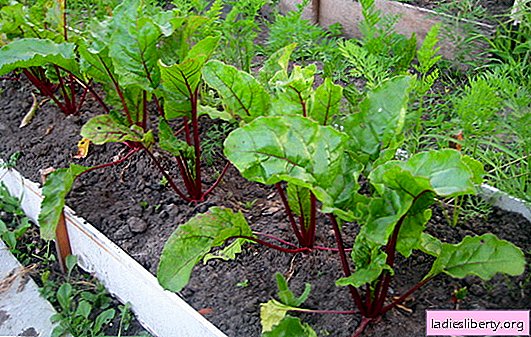
Beetroot is one of the main vegetables on our table after potatoes and carrots.
In addition, it is still used in the treatment of certain diseases and relatively unpretentious.
Therefore, almost every gardener grows beets in their own area.
In order to harvest a rich crop of this root, it is important to comply with the agricultural technology of beets.
Selection of varieties and seeds
Depending on the purpose, fodder, table, leaf, sugar beet varieties have been developed.
Fodder beet grown for livestock feed. Differs in the big size of root crops of yellow, pink, white color.
Sugar varieties used to make sugar. Root crops have an elongated white color.
Chard (leaf beet) cultivated for its succulent fleshy leaves and petioles. However, in Russia it did not receive wide popularity.
On the garden plots are mainly grown beetroot dining. For any climatic region, you can easily find the right varieties of this vegetable.
In terms of ripening beet happens:
• early ripe (ripens in 50-80 days;
• mid-season (vegetation from 80 to 100 days);
• late (grows more than 100 days).
Among the early varieties of the most popular:
Gribovskaya flat - root crops are flat or flat-rounded with pink-red flesh. Resistant to bolting. It has good keeping quality (94%). The crop reaches 3-6,2 kg / m2.
Detroit - cold-resistant variety with spherical shape of root crops. Well preserved, suitable for conservation, resistant to bolting, high yielding.
Mid-season varieties:
Crimson ball differs in high productivity. The shape of the root is round, the flesh is sweet bright red.
Bordeaux 237 resistant to drought. Productivity can reach 4.5-8 kg / m2. The shape of the root crops is rounded or rounded flat, dense juicy flesh has a dark red color. Highly adaptable to cultivation in the northern regions. Well kept.
Don flat 367 different high keeping quality. Root crop rounded, slightly flattened shape. Striped pulp: light pink rings on a red background.
Incomparable A-463 possesses the increased resistance to infectious diseases. Dark red with dark rings the pulp of this variety has a delicate texture.
Cold resistant 19 - used for winter seeding. The variety is resistant to major diseases. It has good keeping quality during winter storage.
Egyptian flat reaches yields of 3.5-6.5 kg / m2. The variety is moderately drought-resistant, the shape of root crops is flat or flat-rounded, the flesh is pinkish-red with lighter rings, juicy, tender. During storage, keeping quality reaches 80-90%.
Cylinder - Dutch variety suitable for preservation, quickly cooked. Root skin is thin, the flesh is dark red, juicy. Root crops of a cylindrical form. The variety has high keeping quality.
The best varieties of late beets:
Monofilament - has a high yield. Its seeds are single-fruited, therefore there is no need for thinning crops. Maroon root vegetables have a dense texture. Productivity reaches 7-8 kg / m2. Greater resistance to varietalism.
Mona - cylindrical roots have a smooth skin, the flesh is dark red with slightly pronounced rings.
Growing beets: sowing and planting
Location
Areas for growing beets are chosen well-lit, given the crop rotation. In the shade this vegetable will develop poorly. In addition, if the groundwater level in the garden is high, then you need to take care of drainage.
Soils
Light and medium loams and sandy loams are optimal for growing beets. If the land is dominated by sandy soil, then it is compacted with sod land, humus or compost (1 bucket / m2). In addition to organic matter, heavy soils are enriched with sand and peat to increase aeration. On low-fertility lands in the spring, ammonium nitrate (30-40 g / m2) is introduced, and in the fall, double superphosphate (40-50 g / m2) and potash salt (60-70g / m2). On soils prone to waterlogging, beets can be grown only on high beds with an additional drainage device. Beetroot grows well on soils with a neutral or slightly alkaline reaction (pH 6.5-7.2). Strongly acidic soils are lime (500-600g of lime / m2) in two steps - in the fall and spring.
Seed preparation for planting
When purchasing seeds, it should be remembered that they cannot be stored at low temperatures. Otherwise, the plants obtained from them quickly begin to bloom at the expense of the formation of root crops.
Beet seeds (collected independently or purchased) must be calibrated before planting and processed to destroy the pathogens. To do this, they are soaked for 30 minutes in a solution of ash (1 tablespoon per liter of hot water) or potassium permanganate and left in clear water for 1–2 days to swell.
To improve the germination of seeds 10-14 days prior to sowing, their vernalization is carried out:
seeds with a layer of 3-4 cm in a deep plate are poured with water at a temperature of + 15-20 ° C for 2-4 days in a 1: 1 ratio and covered with a damp cloth;
after the seeds swell, they are taken out for 7-10 days in a cool room or put in a refrigerator
The harvest of beets from the vernalized seeds can be harvested 1.5-2 weeks earlier than the agrotechnical period.
Planting dates
Germination of beet seeds depends on air temperature. At + 5 ° C, shoots are delayed up to 3 weeks, at +10 ° C they appear for 10 days, at +15 ° C for 5-6 days, at + 20-25 ° C - in 3-4 days. In the central regions of Russia, beetroots are usually sown after the bird cherry blossoms - May 10-15. Mid-season and late storage varieties are sown at the end of May. If sowing is postponed for any reason (cold, inconsistency of soil, rains, etc.), then it can be sown later, but the seeds should be prepared as described above.
Sowing beets
Seeds are planted on the beds of ribbon or lowercase.
With belt landing make long longitudinal rows at a distance of at least 0.5 m from each other.

String method implies sowing in the grooves across the beds. Between such rows they observe 25-30 cm. Sowing is done in previously watered grooves to a depth of 2-3 cm on heavy soils, 3-4 cm on light ones.
Growing beet seedlings
In the northern regions, the most reliable is the method of growing beet seedlings. This allows:
• shorten the growing season of beets in the open field;
• harvest 3–4 weeks earlier than during seed planting;
• eliminates the need for thinning landings;
• reduces arrowhead beet;
• saves seed.
Pre-soaked or vernalized seeds are sown, starting from the last days of March up to the second decade of April, on warmed beds or in a greenhouse. Varieties used early ripening. Planted seedlings in open ground as usual, starting from May 15. If there are threats of night frosts, then landing is better to cover with plastic wrap.
It is better to plant beets after such predecessors as pumpkin (cucumbers, zucchini, pumpkin), potatoes, onions, legumes.
Growing beets: care, feeding
It is simple to care for beetroot: regular watering, periodic loosening of row-spacings together with weeding, thinning, feeding.
Watering
Beet moisture-loving culture. Increased need for watering it arises during the period of active growth and during the filling of root crops. In hot sunny weather, young beets are watered three times a week, in the morning or in the evening. Adult plants need only one abundant watering a week, and then only moisten the soil. 2 weeks before harvesting, watering is completed, otherwise the keeping quality of root crops during storage will be low.
Loosening
2-3 days after sowing, they start to loosen the aisles, so that the soil crust does not interfere with the germination of beets. Also, loosening is necessary after each watering or heavy rain.
Thinning
Seeds of beet are plentiful. Therefore, from each seed grows several plants. And no matter how carefully you measure the seeds when sowing, there is a need for thinning.
The first time it is made when the beets have two true leaves. At the same time pull out weaker seedlings and transplanted to empty places. Re-manipulation is carried out when the beets have 4-5 leaves. Until mid-August, a third thinning should be carried out, in which suitable edible specimens are selected, and the sick and ugly are removed. The distance in the row is left 6-8 cm, so that the roots will not grow. The procedure is carried out after watering or rain: the plants are pulled out more easily.
Top dressing
After the first thinning, 20-30 g of mineral fertilizers per 10 liters of water are applied to the beds. Before closing the rows, make a second feeding of ammonium nitrate and potassium salt (20-25 g and 40-50 g per bucket of water). In addition to the basic fertilizers, it is also necessary to introduce trace elements, especially boron and manganese, with a lack of which the core of the roots "softens." After any feeding crops need to be watered abundantly.
Beets are prone to accumulation of nitrates, therefore, it is not possible to add fresh manure to it.
Growing beets: harvesting and storage
Harvesting beets depends on the time of sowing, weather, variety, cultivation region. It is desirable to remove the beets before the onset of the first frost, to prevent its freezing, cracking and decay.
Signs by which you can determine the readiness of root vegetables for harvesting are:
• ripened beets have reached their varietal size;
• on the roots appeared small side roots;
• Lower leaves wither and turn yellow.
Mid-season beets are harvested at the end of August, late ripening - in the first decade of September.
It is necessary to dig beets in dry weather, trying not to damage the skin of root crops. Pour the ground from them must be cleaned or washed off. The tops are cut 1-2 cm from the root of the root. Well-dried vegetables are stored in bulk on floorings or in sandboxes in cellars or cellars.
Major pests and diseases. Ways to deal with them
• Cornet (black leg) caused by various parasitic soil fungi. The disease is most dangerous for young shoots. The root and stem rot, a black constriction is formed on them. Shoots wither and die. Excessive moisture with low soil aeration contributes to the development of the root. The disease is spread with infected seeds. Therefore, for prophylaxis before sowing, they are calibrated and disinfected with fungicides. It is also necessary to destroy weeds, observe crop rotation.
• Brown rot caused by fungus. In the roots grows mycelium brown. Most often, the defeat of root crops occurs in areas where groundwater is close to the surface. To combat the disease, it is necessary to sort the vegetables during storage, loosen the aisles, feed them with boric fertilizers, lime the acidic soil, observe crop rotation.
• Perinosporosis (downy mildew) mainly affects young plants in the phase of closure. The leaves of the leaves curl downwards. A gray-violet mycelium grows on them from the lower side. The fungus spreads by air currents, water droplets, winters in plant debris. Therefore, they must be collected and burned after cleaning. Seeds before planting are disinfected, plants are sprayed with preparations containing copper (for example, Bordeaux mixture).
• Cercosporosis - a fungal disease, affects the ground part of the beet: on the leaves appear a lot of bright spots with a red-brown border. With increased humidity on these spots grows a grayish patina of mycelium. Leaves dry up with a strong lesion. At the first signs of infection, plants are sprayed with preparations containing copper. After harvesting the plant residues are burned, the soil is dug up.

• Fomoz appears on leaves with light brown spots with black sporangia in the center. At root starts dry rot. For the prevention of the disease should be observed alternating crops.
• Beet flea - small jumping bugs in black. On the cotyledons, they eat the flesh, on the leaves are characterized by translucent "windows". When dry weather damaged seedlings die. Adult insects overwinter on the soil surface in plant debris. Weed control is necessary to control flea weeds, which are intermediate feed bases for pests. With a large number of pests can use karbofos. It is effective to dust the crops 2-3 times with a mixture of tobacco dust and lime fluff (or ash) (1: 1) with an interval of 4-5 days.
• Beet nematode: the larvae of this pest harm, parasitizing inside the beet roots. The leaves wither, acquire a yellowish-green color. Beets are not planted in the infected area for 4-5 years.

• Beetroot bug and its larvae suck the juice from the plants. Damaged leaves become pale, shrink, then turn brown and die. Females lay wintering eggs on beet seed plants and weeds near beets. In this regard, weeds should be destroyed, in the fall, rake and burn plant residues. The larvae and the imago are destroyed by spraying insecticides.











